
Photo: Octavio Real The “arpillera” is colossal: it contains 1,600 figurines representing the dead and disappeared of the Chilean dictatorship. In our photo, a detail of the work of the Colectiva Crear Poder Popular.
Camila Lewandowski Montreal
Published at 0:00
- Americas
After hundreds of hours cutting and sewing pieces of fabric to create small figurines representing the thousands who died and disappeared during the Chilean dictatorship, the Montreal artists of the Colectiva Crear Poder Popular (the Create Popular Power Collective) wish now bring their work to South America.
“For us, it is important to pass on this gift of exile from the Chileans who have lived in Canada for 50 years,” explains Carolina Echeverria, co-founder of the collective. “So that the exiles do not die in invisibility, in oblivion,” she specifies.
Thus, the Colectiva Crear Poder Popular, led by five Montrealers of Chilean origin, is seeking to raise $32,000 to present the work in universities and museums in Chile, Argentina and Uruguay starting at the end of August.
The canvas ofarpillera, a fabric with a rough texture specific to Chile, is colossal, at five metres wide and two metres high. Placed on a navy blue canvas, each figure represents one of the 3,200 people who have disappeared or died, according to the Chilean government’s National Truth and Reconciliation Commission report, better known as the RETTIG report.
Using this type of fabric was a conscious choice, explains Sarabeth Treviño, a founding member of the project. The embroidery of the arpilleragained popularity thanks to Violeta Parra, an iconic folk singer of the new Chilean song during the sixties. “It was a weapon of resistance, because women began to depict their feelings, their history, but also to denounce what was happening at that moment in history, such as arrests, disappearances and torture,” explains Treviño.
To never forget
More than a thousand people have joined the Colectiva Crear Poder Popular over the past year to pay tribute to the victims of the dictatorial regime of Augusto Pinochet (1973-1990). Some have attended the workshops religiously, others go from time to time. Those who live too far away have sometimes sent their fabric figurines by post to participate, even remotely, in this collective work.
So far, half of the dead and missing have been represented in the form of figurines. The participants, who come from a wide cultural diversity, sit on the floor or at a table and begin to cut and sew the arpillera. But before doing so, “the participant who makes the textile representation of the person also takes the time to read this story out loud,” explains Gisela Frías. She adds that a ritual has been established during the workshops, in which the participants address the dead or missing person by saying: “You will be present now and always.”

Photo: Colectiva Crear Poder Popular Over the past year, more than a thousand participants have contributed to the creation of the “arpillera” across Quebec.
Her colleague, Ms. Echeverria, adds that the Colectiva Crear Poder Popular “was able to free the missing people who were frozen in time for fifty years in a black and white image.”
The other 1,600 figurines will be woven starting in October, when the creation workshops resume. The work should be completed by fall 2025. The five women will present the finished work in three cultural centers in the boroughs of Rosemont–La Petite-Patrie, LaSalle and Notre-Dame-de-Grâce. Last winter, the arpillera was notably presented at Montréal en lumière as well as at the Musée POP in Trois-Rivières, as part of the exhibition Changing the world, one work at a time.
Healing through art
The canvas ofarpillera also helps to heal. Denise Andrea Olivares, co-founder of the collective, lost family members during the dictatorship, but she was never able to grieve properly, since she was only a child at the time. “I was very young, so I didn’t have the opportunity to say goodbye or pay tribute to them in my own way. By representing them, I was able to do that,” she says.
All five women have been affected by the Chilean dictatorship in one way or another. Some have lost loved ones, others have been forced into exile abroad for fear of reprisals. “When we looked at the list of performances we have done,” explains Treviño, “we realized that those closest to us were there [in the work].”
Giving body and soul
The making of the arpillera was entirely thanks to the participants who gave their time. “Everything we have done in the last year has been without financial help,” explains Carolina Echeverria. But we have reached a point where the project is so big that we cannot continue without funding.”
The five women launched a GoFundMe campaign two weeks ago to fund the work’s transportation to South America and their plane tickets for the end of August. Echeverria explains that it is very important for them to bring the work to South America to also pay tribute to all the people who, for almost half a century, had to go into exile from Chile. “The Chileans were the first Latin Americans to arrive in Canada,” says the co-founder of the collective, “and we want to show what those 50 years of exile were like.”
In addition to Chile, the arpillera will also be sent to Uruguay and Argentina, two countries that received a large number of Chilean exiles during the Pinochet regime. “It was necessary for this healing to be shared by all Chileans who are in exile and who are going to die outside their country of origin,” emphasizes Ms. Echeverria, who herself left Chile for fear of persecution. “This legacy can fill the absence that our own departure left. Each of us represents that: the absence and the part of what we could have been.”
In the meantime, the women in the collective are waiting for a response to their grant application from the Conseil des arts et des lettres du Québec, which should reach them in the coming days.
To date, the five women have only raised $1,200, a sum well below what they hope to collect by the end of August. They remain hopeful, however. “There was a lady who even offered to sell empanadas to finance our trip,” says Ms. Echeverria.

